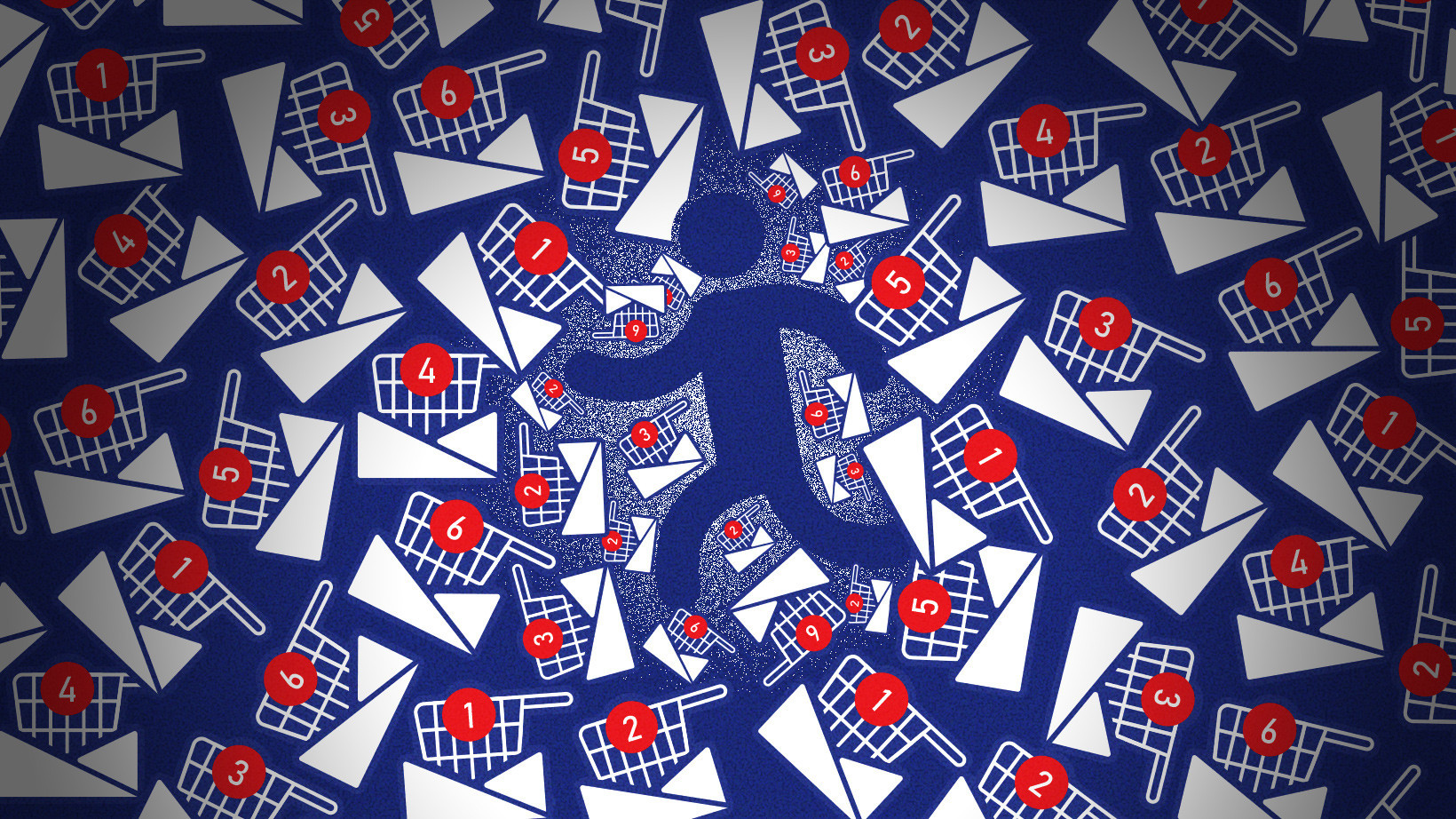Do Domestic Webshops Deal with Email Retargeting?
Only 30% of Hungarian webshops use shopping cart retargeting emails to retarget their potential customers. Moreover, those who make use of this method, do not really do it in a professional manner. However, most of them embed the content of the cart into the email, but there are still untapped areas concerning this topic. We have examined 57 Hungarian and 23 foreign webshops to show you these unexploited areas.
Shopping cart retargeting is a follow-up activity targeting those visitors who have already been on your website and put one or more products into their carts, but at the checkout, they decided to leave your website without finishing shopping.
What was the aim of the research?
We wanted to find out how consciously shopping cart retargeting as the most obvious CRO tool is used, primarily by domestic webshops. Why is this tool the most obvious? Because in webshops, on average 70% of customers (Baymard) decide not to finish shopping after having put a product into the shopping cart. Of course, this may have several reasons.
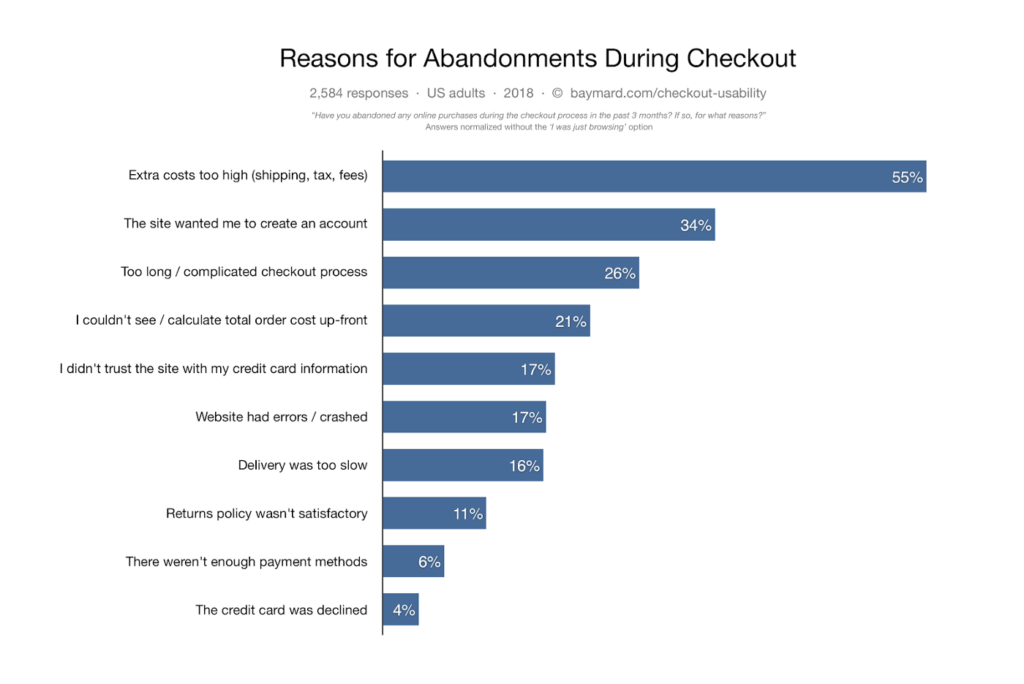
One thing is for sure: on the one hand, the product did not get into the shopping cart by accident, on the other hand, there must have been a reason why the visitor left it there. If we manage to identify these two reasons clearly (even by means of an exit intent survey) and we also have the user’s authorisation to use their data for this purpose, nothing will prevent us from sending a perfectly customised retargeting email to the potential customer concerned, which, in addition to instant purchase, can also increase loyalty in the long run.
Based on Conversion’s data, shopping cart abandoners do the following after getting the email:
- 30% of them buy something within less than 20 minutes after getting the email,
- 50% of them buy something within 20-60 minutes after sending the email,
- 60% of them buy something within 1-3 hours after sending the email,
- 65% of them buy something within 3-12 hours after sending the email.
If we do not apply shopping cart retargeting, the 70% dropout may cause considerable loss of income, despite the fact that these potential customers can be converted into real customers more easily than those who did not put any products into the cart on our website. In light of the above, there is enormous potential in retargeting shopping cart abandoners.
But how big is this potential expressed in figures?
According to Moosend’s statistics, the opening rate of shopping cart retargeting emails is about 45% on average, the click-through rate is 21% and 50% of clicks result in purchase. Consequently, we can calculate with a conversion rate of around 4% and an average income of USD 5.64 per email (which is only USD 0.02 on average in the case of promotional emails). Based on the above, retargeting does not seem to be such a bad business at all.
“Retargeting” may happen in several ways:
- Onsite: we already retarget with an “exit intent” campaign before the customer leaves the website. In other words, we make an attractive offer to the user who is about to close the website, so that they may decide to stay / buy something. Perhaps a UX expert may disagree, but this solution can be very effective from the viewpoint of e-commerce. This is kind of an odd one out in retargeting, as it rather serves to prevent the actual abandonment of the shopping cart.
- With retargeting / remarketing campaigns: we retarget our users on other websites with offers related to the product abandoned in the cart. In this case, it is worth considering several things. For example, is it worth retargeting with the same product or rather with a product from a similar category or only with a general message? Another question is timing. It may be a bit irritating for users to find the product that they have just viewed one second later when they go on Facebook.
- By email: if our user consented to the use of their data for this purpose, we can also contact them by email after the abandonment of the shopping cart.
Out of the three options described above, we examine the last one in this research (based on data collected in August 2018), as we were able to collect data for this method with a high percentage accuracy.
Methodology:
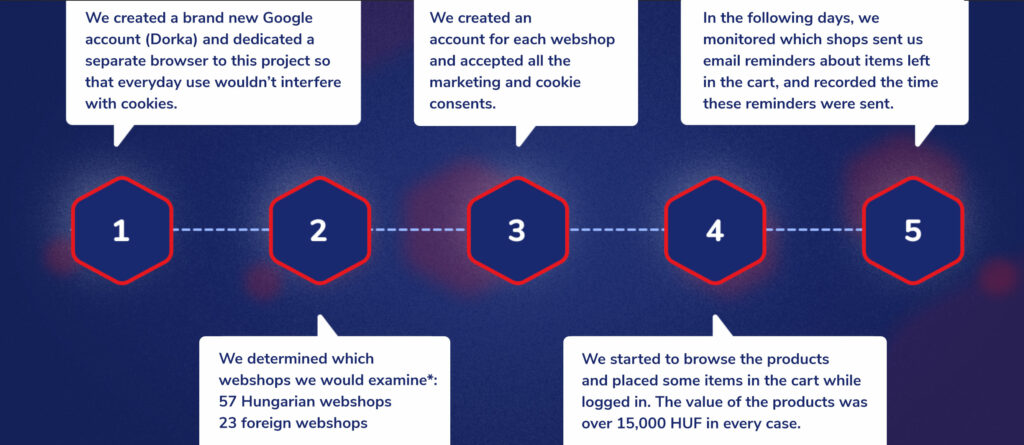
Results yielded by the research. What do the figures show?
Despite the great potential in retargeting, only about one-third of the webshops sent us an email after the abandonment of our shopping cart. This rate was the same when we considered only foreign or only Hungarian websites, therefore we are not behind the foreign average. Although this rate may seem to be low, it does not mean that the remaining 70% do not use any retargeting solutions at all. Our current research, however, focused exclusively on emails. One thing is for sure, the changes in the GDPR last year did not favour the conversion optimisation solutions described above, as in many cases the users’ consent had to be collected again, sometimes with a more detailed Data Processing Policy.
Quantity
However, some difference can be discovered between domestic and foreign examples regarding the number of retargeting emails sent by webshops, related to a specific shopping cart. A slightly higher percentage of foreign webshops send more emails: Hungarian shops send 1.5 emails on average, while foreign webshops send 2.1 emails. Examining all webshops, 35% of them send more than 1 email, thus helping conversion with reminders.
The most extreme example was eBay; in my opinion, their approach falls into the harassment category: they keep sending you emails until you remove the products from your cart. And they save your cart for 365 days.
When using this tactic, it is also worth paying attention to how long we keep the customer’s shopping cart and how long we run the related retargeting campaign, because receiving a lot of emails can be irritating when you are just browsing after actual purchases without deleting your entire cart. Of course, this factor is product-specific. In the case of lower value products, you should not ‘pester’ potential customers for months or even weeks, because a bad experience may lead to boycotting the whole webstore.
Timing
In addition to considering the number of emails, we also examined the time that elapsed between the purchase and the arrival of the first email in our mailbox. The email arrived in 83% of the cases within one day, more specifically:
- 9% send an email within 12–24 hours,
- 56% send an email within 3–12 hours,
- 35% send an email within 1–3 hours,
- However, no email was received within 1 hour.
Based on the above, webshops in our research do not take advantage of the so-called golden hour, when, based on statistics, the conversion rate can be the highest.
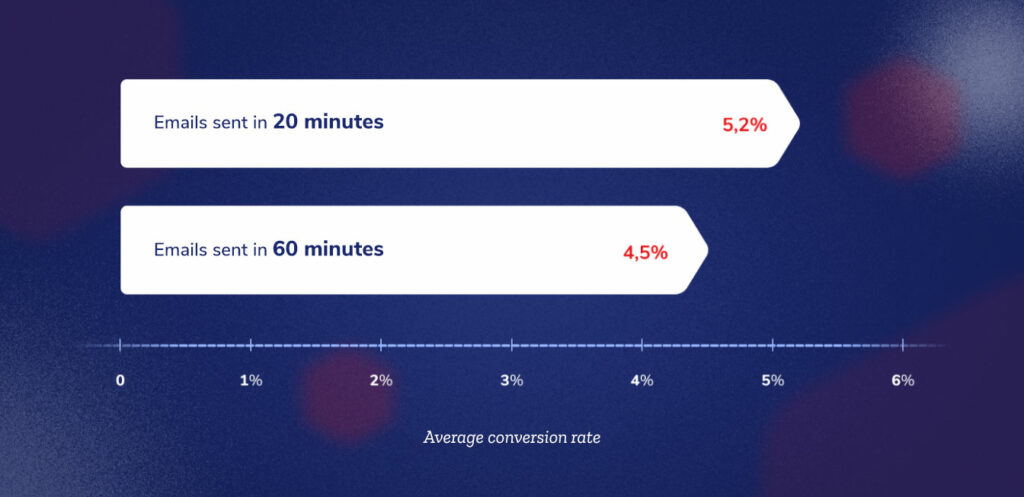
It may be worth using automated emails and also testing the idea of dispatching within 1 hour, based on the hot shopping cart theory, which may be expressly effective when combined with a reference to where the user came to our website from. In certain cases, we might try to reattract visitors arriving from price comparison websites (they tend to see different offers for a given product from several websites) by making a favourable offer.
Content
Talking of a better offer, we must mention another essential thing: the content of the email. Several webshops already put a spoiler in the subject of the email, referring to the discount they offer on the given product:
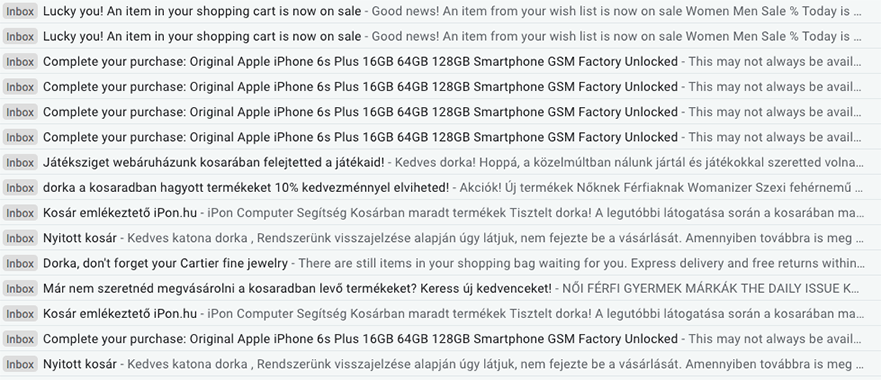
35% of retargeting emails contained some kind of promotional coupon code, should the customers reconsider their decision on the purchase. These coupon codes mainly offered percentage discount on the product, free delivery or the possibility of returning the product free of charge. Foreign webshops used such offers more often: 43% of the emails contained some kind of discount, while in the case of Hungarian webshops this rate was only 31%.
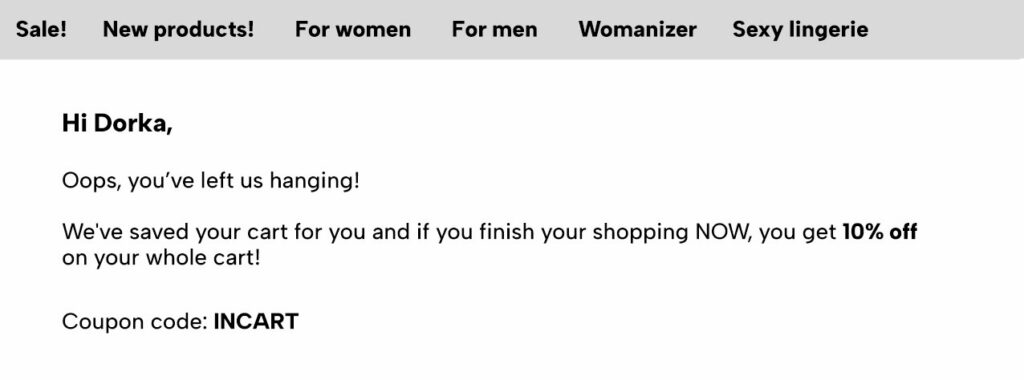
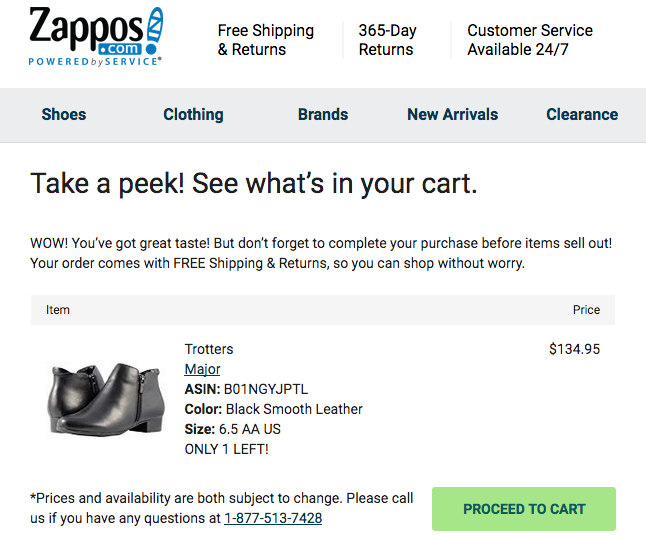
If the customer hesitates but actually would like to buy the product they put into their shopping cart, such coupon codes can be very effective, as they give the last incentive to make the decision, or the customers might buy the selected product in our webshop instead of other webshops exactly because of the coupon codes. Moreover, it is easy to test what kind of discount leads to the highest conversion rate regarding these emails. It does not mean that we have to become cheapjacks and off a product with a 20% discount when its margin is merely 30% anyway. Instead, we can even build on existing discounts, such as free delivery. If the customer hesitates because of the size, we can emphasise that the product can be returned free of charge for up to 30 days if it does not fit. We could also build on urgency. We might communicate that there are only a few pairs left from the selected shoes, or the discounted price is granted only for that week. 21% of the webshops applied communication based on urgency.
There was a webshop that tried to put different variations of emotional pressure on the customers:
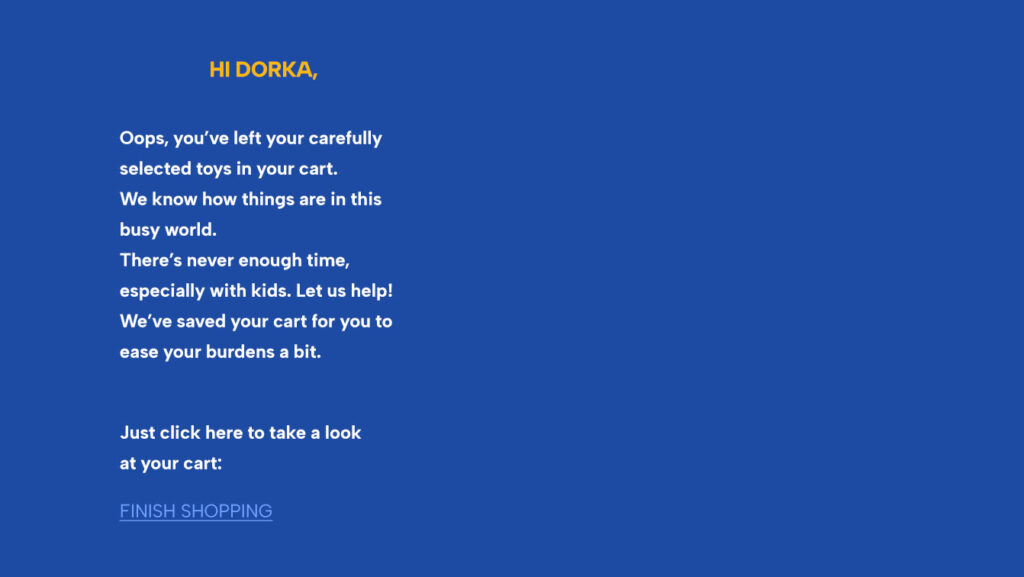

This webshop already sent a coupon code in its second email, however, they did not write what the gift applied to (neither the percentage of the discount, not what exactly it was on).
83% of the emails referred to specific products. Regarding rates, there is no significant difference between domestic and foreign webshops. Although it is a controversial question whether it is worth recommending the same product or rather something similar, as the original product was not very convincing for the customer, based on the examples, the market clearly prefers the product that has already been put into the shopping cart. Of course, some webshops add other related or similar products, but in such cases the main offer always contains the product originally chosen by the customer.
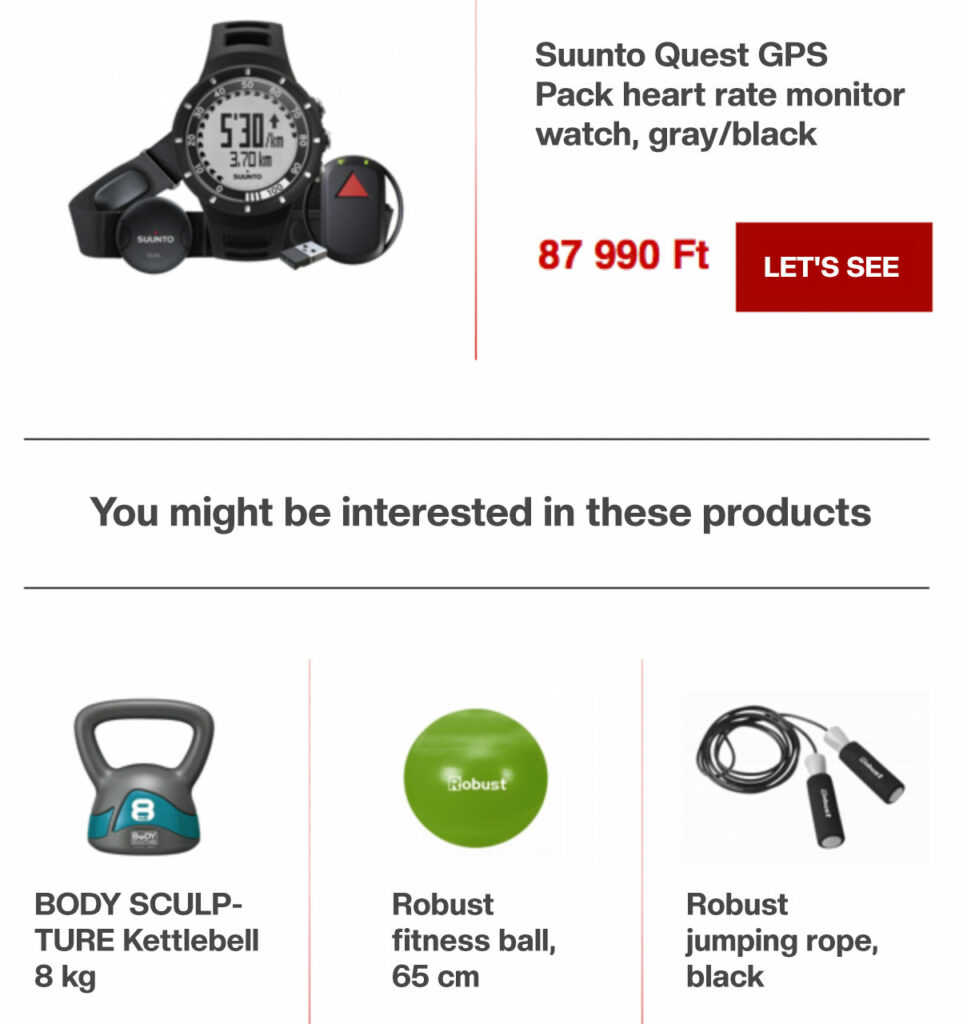
Customised emails may seem to be an old chestnut, especially, when it comes to how to address the recipient. 52% of the webshops used only the first name of the recipient (e.g. Dorka) in their email, while 13% of the webshops use the first name only in the subject of the email. The address “Dear Dorka” was the most common, but one email used the expression “Dear Madam”, which was a bit strange.
The use of social proof or customer reviews may be the last push for the customer. These instruments are used in shopping cart retargeting emails. Typically, Booking.com applies them on their webpage and their letters. Surprisingly, we did not receive any email from them during the research (probably due to our completely unused account). At the same time, there was one webshop where this incentive was present, but not too dominantly: eBay’s email included the term “130 inquiries”, close to the CTA button.
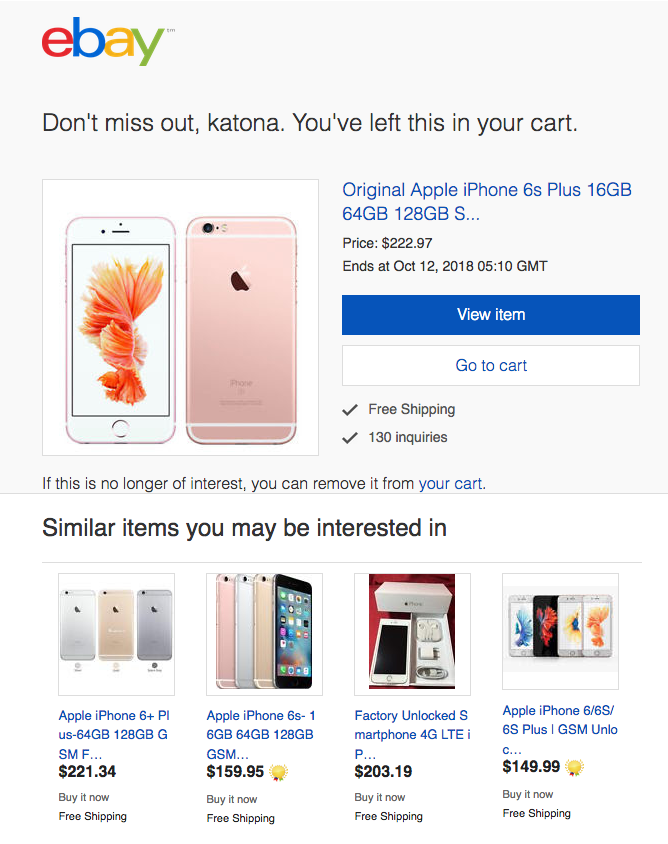
There were some webshops which could be textbook examples for a shopping cart retargeting campaign, as they combine content elements with frequency very well. They tend to send three letters. The first mail contains only a reminder: you left something in the shopping cart (they show the product concerned). In the second email, they provide some kind of discount, while in the third letter, a more considerable discount / free delivery is offered. If you decide not to buy the product despite their endeavours, they let you go and do not bombard you with further emails. In my opinion the clear winner was Zalando with the following emails:
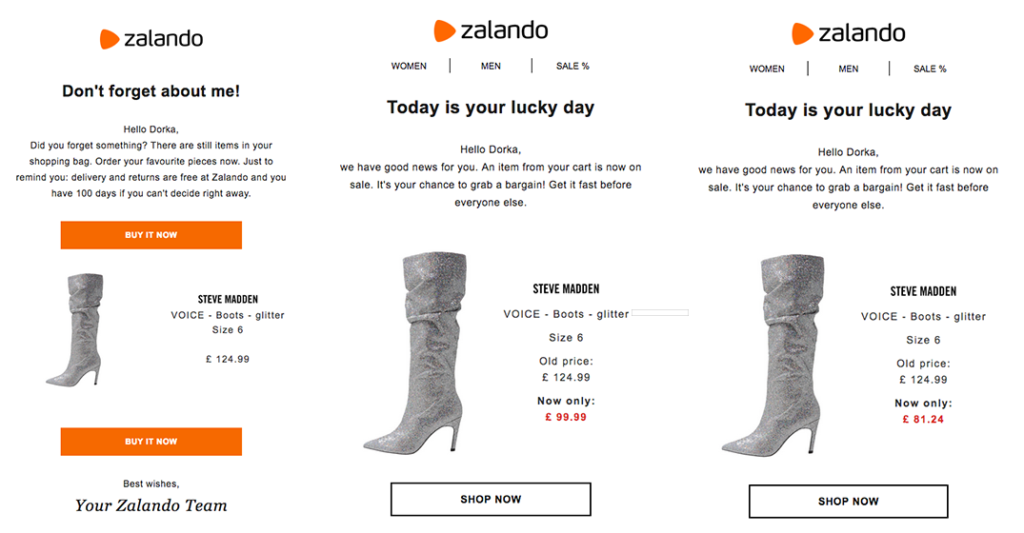
In the light of the above, what should you pay attention to when sending shopping cart retargeting emails?
Strategic aspects
- Investigate the main reasons and circumstances of the shopping cart abandonment and react to these in your emails.
- Automate your emails by taking advantage of the golden hour after the abandonment of the shopping cart.
- Do not build on a single email, test the reminders as well.
- Customise your email if possible (subject, address, stylistics, related offers, CTA).
- Do not be afraid of embedding reviews and social proof contents.
- Test similar product offers by using mainly pictures.
- If your budget allows, test the power of discounts and coupons, but make sure that they are clearly understandable.
Aspects of content
- Write an attractive copy to the subject and the preview. Test the keywords if possible.
- The email should focus on the product(s) left in the shopping cart. Show the details of the shopping cart (high quality photo, name, price, etc.).
- Use a clearly visible CTA button.
- Show the discounts and advantages related to delivery (if any) (e.g.: free delivery, 1-day delivery, etc.).
The most important tip is the following: no matter how optimised our website is, there will always be visitors who do not complete their shopping. The best thing we can do is to retarget them by email and, if we have their marketing consent, test which of the elements (or their combination) described above work best in connection with the given product category in our webshop. If we cannot contact shopping cart abandoners by email, it is worth applying other retargeting solutions to minimise the loss of potential customers.
In addition to agency jobs, Mito Creative and Digital Agency is also involved in serious developments. We are very proud of being able to deliver web and mobile solutions to, inter alia, OTP Bank, Magyar Telekom, Deutsche Telekom, WIZZ Air, Szerencsejáték Zrt. and the lottery company of Iceland.
The author(s)
Marietta Srágli
E-commerce Consultant
